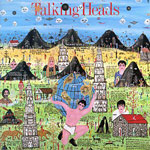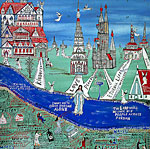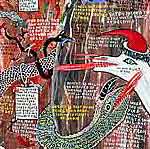Cover for Talking Head's Little Creatures
 |
One might call the recent passing of Howard Finster at age 84 "Death of a Salesman." The Alabama-born preacher, who drew his sermons on plywood with dime-store paint and Magic Markers, hawked them with phenomenal success.
Although he was an untrained artist with only a sixth-grade education, Finster knew how to survive and succeed as an artist. His work appeared on rock music album covers, in museums and in galleries worldwide. He was featured in Time and Life and on Good Morning America and The Tonight Show with Johnny Carson. He built a kingdom in Georgia, a kind of handmade Graceland he called Paradise Garden, complete with his own museum and chapel that became one of the state’s top ten tourist attractions.
His art career began unexpectedly in the late ‘40s. He had been evangelizing at tent revivals since he was a teenager. The revelation came while he was applying paint to a bicycle with his fingers. A face appeared to him on his soiled thumb telling him to forget preaching and paint sacred art. The calling produced 35,000 paintings, angels, mostly, with messages, such as "Hell is a hell of a place."
Whether you think Finster’s work is heaven-sent or hare-brained, you can‘t say it was bad business. It enabled him to buy a 4-acre tract a few miles from Paradise Garden in an affluent section of Georgia, where he built a brick ranch with a pool and pool house.
The question that goes pleading here is: Why did Finster’s art attract so many fans when other contemporary artists struggle for patronage?
One answer may lie in the known reason for art vandalism. Studies show that art vandals are often ordinary people expressing anger at being excluded from an elite world. This is particularly true of attacks on abstract art, which speaks to a relatively small number of people. But other kinds of art can be head-scratchers, too; i.e. the splotch of plastic vomit called "The Sweet and Pungent Smell of Success" at a Whitney Biennial. Reportedly, vandalism against contemporary art is a protest against alienation.
Holy Virgin Mary
 |
A retired English teacher smeared white paint over Chris Ofili’s "Holy Virgin Mary" at the Brooklyn Museum not long ago because it showed the subject surrounded by cutouts of female genitalia and her breast made of elephant dung.
Such defacings are applauded by the general public—a clear indication that the rank and file don’t get contemporary art, either. Worse, they think it a bad joke.
The celebrated smartie Marilyn Vos Savant, who writes a column for the weekly Parade magazine, even thinks Picasso’s work is a joke. Responding to a letter writer who asked her to explain Picasso's reputation as a great artist, Vos Savant answered by mocking not just him, but all of modern art, comparing it to garments for the emperor in Hans Christian Andersen's fairy tale "The Emperor's New Clothes." Remember? That was the one about non-existent threads that no one wanted to acknowledge were non-existent for fear of appearing ignorant.
But you don’t have to be art-smart to get Finster’s work. It’s simple, it’s clear and the subject-matter is uplifting. And if you still don’t get it, Finster gives you his words to go by. "He That Believeth Not Shall be Damned," he wrote on a painting on display at the Smithsonian Institute in 1990. Next to it, the museum staff wrote an explanatory note: "The historical, popular, and biblical objects of Finster’s portraits embody his concept of the inventor as someone whose creative process will provide the world’s salvation."
 
Click on these images to see a larger verstion.
Finster’s work didn’t need the explanation.
|